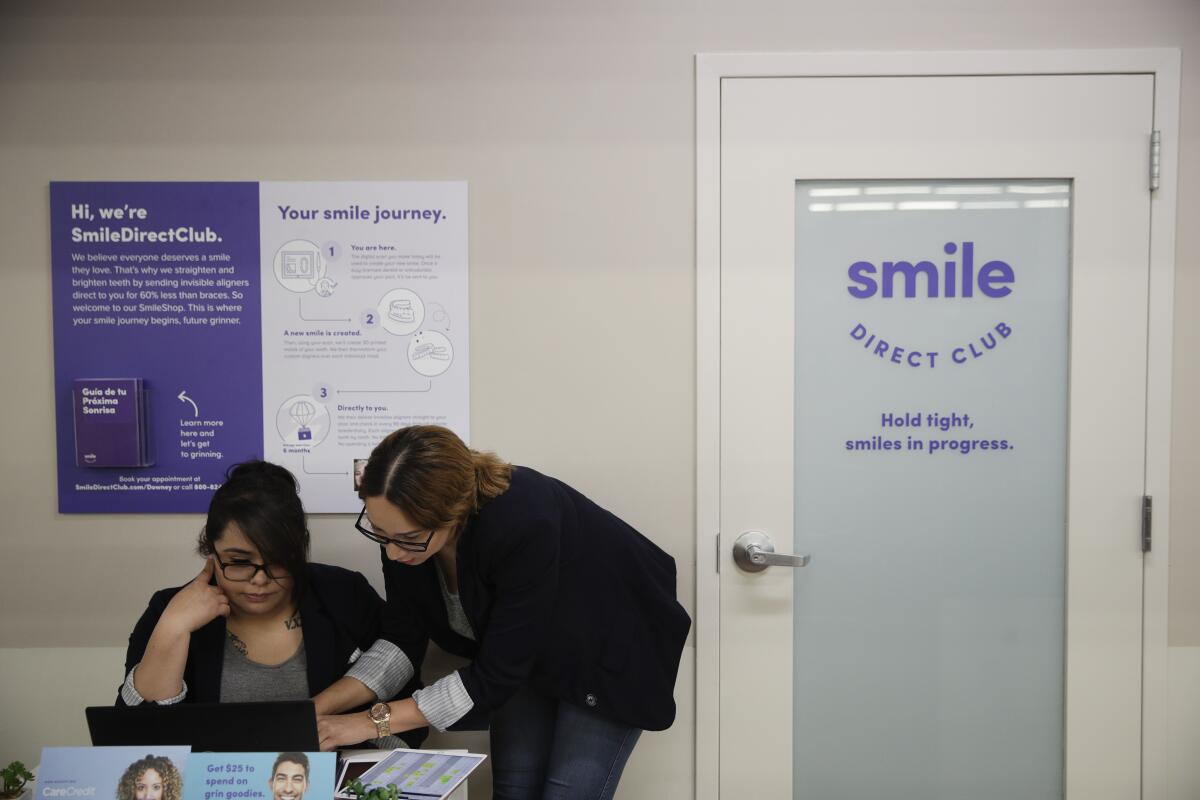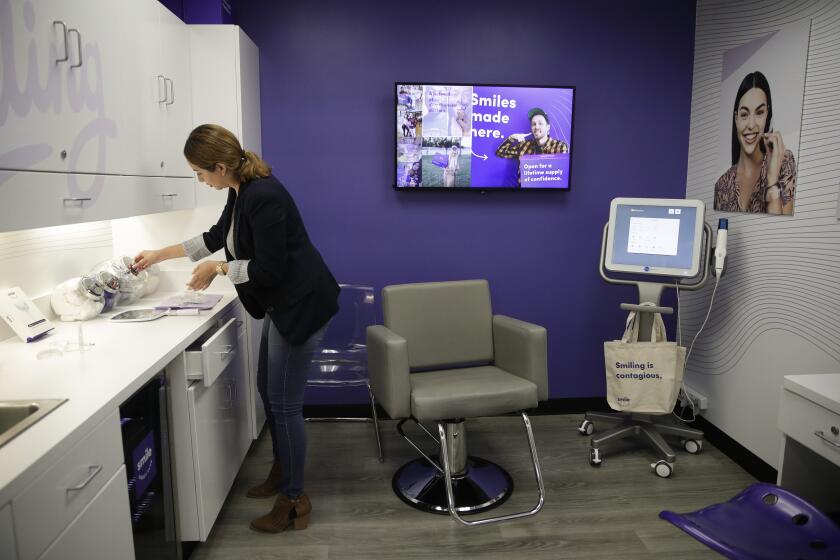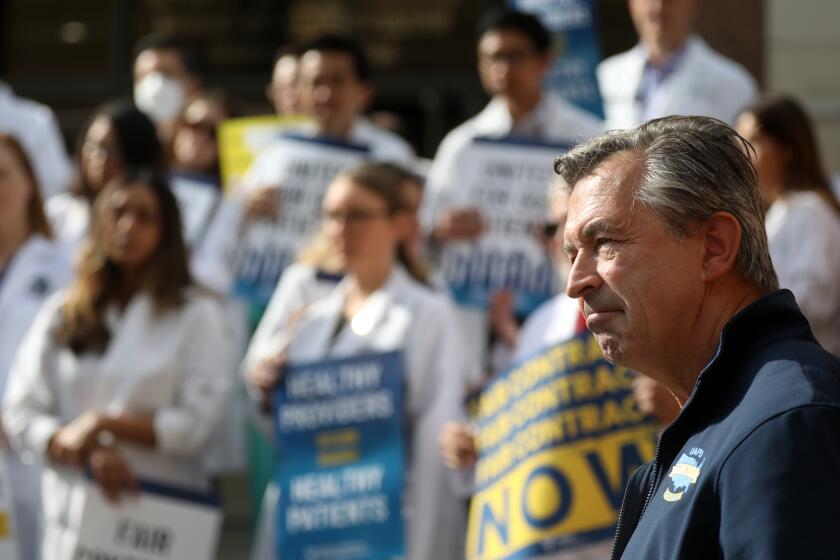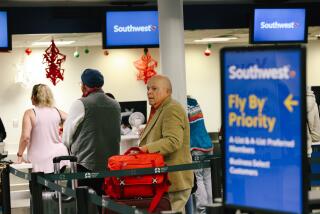SmileDirectClub is shutting down. Where does that leave its customers?

- Share via
Just months after filing for bankruptcy, SmileDirectClub has said it is shutting down its global operations and halting its teeth-aligner treatments.
That leaves existing SmileDirectClub customers with a lot of questions and few answers. The Nashville, Tenn., company is offering no more customer care support, and few details about possible refunds are available yet.
Multiple dental organizations and orthodontists have cautioned patients about safety concerns arising from “direct-to-consumer” dentistry.
Here’s what you need to know.
What is SmileDirectClub? Why is it closing?
SmileDirectClub — which served more than 2 million people since its 2014 founding — once promised to revolutionize the oral-care industry by selling clear dental aligners that were marketed as a faster and more affordable alternative to braces. It sold its aligners directly to consumers by mail and in major retailers.
Teeth-straightening firms do not make information public about success rates or problems.
When SmileDirectClub’s shares began trading on the stock market in 2019, the company was valued at about $8.9 billion. But the stock plummeted in value over time as the company proved to be unprofitable year after year. In 2022, SmileDirectClub lost $86.4 million.
With its stock price tumbling, SmileDirectClub was pressured to spend on acquiring customers to demonstrate its business could grow, said Eric Snyder, chair of bankruptcy at law firm Wilk Auslander.
“And then you combine that with the legal battles they had [and pushback] from the orthodontics industry ... all those things together just made it really hard for them to stay competitive,” he said. “They’ve been losing just tremendous amounts of money over the last couple of years.”
SmileDirectClub filed for Chapter 11 bankruptcy protection in September while reporting nearly $900 million in debt. And at the end of last week, it confirmed it was shutting down operations after being unable to find a partner willing to bring in enough capital to keep the company afloat.
What about existing customers?
In a list of Frequently Asked Questions posted Friday about it shutting down operations, SmileDirectClub confirmed that its telehealth aligner treatment is no longer available.
That leaves existing customers in limbo.
Physicians and dentists at county-run facilities could go on strike to protest what their union describes as inadequate benefits and rampant vacancies.
Customer orders that haven’t shipped yet have been canceled and the Lifetime Smile Guarantee no longer exists, the company said. SmileDirectClub added that Smile Pay customers are expected to continue to make payments, leading to further confusion and frustration online.
Customer-care support has also ceased. SmileDirectClub apologized and urged consumers to consult their local dentist or orthodontist for further treatments.
The telehealth company said that more details about refund requests will arrive “once the bankruptcy process determines next steps and additional measures customers can take.”
When contacted by the Associated Press for additional information, a spokesperson said the company couldn’t comment further.
Now that SmileDirectClub is out of business, Snyder said he is skeptical about compensation making its way to customers — but noted that people who signed up or made payments after the company’s September bankruptcy filing probably will be prioritized.
“Unfortunately, I think they’re going to be out of luck. ... [But] if there’s any money, it’ll go to the newest customers,” Snyder said.
He noted that even when a company goes out of business, consumers still paying off bills for services they already received will still owe that amount.
Snyder doesn’t expect there to be further legal implications around the end of the Lifetime Smile Guarantee, noting that such warranties are “only as good as the life of the company offering it.”
It’s unclear how many active customers SmileDirectClub had before shutting down, but American Assn. of Orthodontists President Dr. Myron Guymon speculates that tens of thousands of people could be affected.
“That’s got to be very frustrating for them to have spent time and money in a treatment, and then all of a sudden the rug gets shoved out underneath their feet,” Guymon said.
He and others advised those people to seek the care of a professionally trained orthodontic specialist, such as those listed on AAO’s website.
These dental recommendations can help you avoid the brunt of sugar’s impact, not only at Halloween, but also year-round. Help keep your kids’ teeth healthy.
What are orthodontists saying?
Over the years, dental associations around the world have been urging caution or expressing opposition to direct-to-consumer aligners — what some call “DIY” dentistry.
These types of aligner treatments don’t require in-person visits to a dentist or orthodontist but typically ask consumers to take molds of their teeth or a digital scan instead. This can lead to key aspects of a patient’s oral condition being overlooked and potentially lead to health consequences, some experts say.
“It’s very easy to cause harm if you’re not properly monitoring the case,” said Dr. Thikriat Al-Jewair, chair of the Department of Orthodontics at the University at Buffalo. “I cannot overstate the importance of seeing an orthodontist to monitor the care. [Moving teeth] is a very complex process and also very individualized.”
Al-Jewair said that many former direct-to-consumer aligner patients end up coming to orthodontic practices for reevaluation. In these cases, she said, gum disease, bite problems and other issues often arise.
It’s important to note that SmileDirectClub isn’t the only direct-to-consumer aligner provider today.
The treatment’s appeal and perceived benefits boil down to convenience and affordability.
SmileDirectClub has previously specified that each of its customers’ treatment plans and health histories were reviewed by licensed doctors, who could also request additional information or reject some people for the company’s teledentistry care.
But this kind of business model still brings up concerns for the orthodontists group, Guymon said. An initial in-person evaluation isn’t required, he said, and supervising doctors are not always identified to patients.
“Our concern has always been that the lack of direct supervision, the lack of a patient-doctor relationship [and the fact] that the patient didn’t know who to call if they had problems, was not in the public’s best health and interests,” he said.
That doesn’t mean there isn’t a place for telehealth in the dental world, Guymon and others said, noting that remote monitoring between treatments, for example, can help patients with convenience and alleviate some cost barriers of orthodontic care.
“We absolutely support teledentistry and many of our members use it, but just within certain safety guidelines,” said Trey Lawrence, the orthodontist group’s vice president, general counsel and head of advocacy. “Patients can check in with their dentist [remotely], but also maintain knowing who your dentist is and being seen in person before you start something more permanent, like orthodontic treatment.”
More to Read
Inside the business of entertainment
The Wide Shot brings you news, analysis and insights on everything from streaming wars to production — and what it all means for the future.
You may occasionally receive promotional content from the Los Angeles Times.













